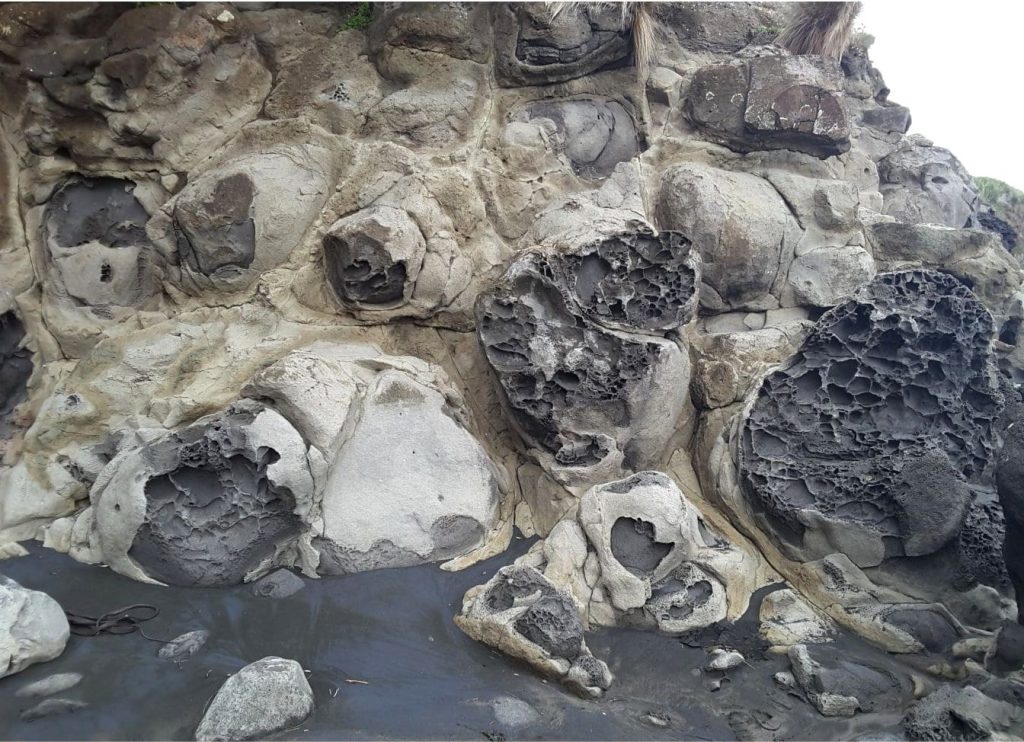

Spheroidal weathering of Pliocene basalts, plus dog; Karioi volcano, Raglan, NZ. The lighter coloured rinds are more recessive than fresh basalt. The sub-vertical fractures are remnants of original columnar cooling joints.
One of the beaches we frequent, off the beaten track and commonly deserted, has at its south end cliffs of basaltic lava flows. The flows are late Pliocene and accumulated on the flanks of the Karioi volcanic complex (Ruapuke, west coast North Island, New Zealand). A standout feature of the exposure is their weathered profile, block upon fitted block of spheroidal rinds, onion-like, peeling, with superimposed honeycomb weathering.
Spheroidal weathering is a common surface phenomenon, particularly in rocks that have pre-existing blocky fractures. The Karioi basalts (and andesites) contain columnar joints approximately perpendicular to flow boundaries. Each column is segmented by regularly spaced horizontal joints. Both joint sets developed during cooling of the original lava flow. These 3-dimensional fracture patterns produced blocks that, when exposed to the elements, are the precursors to spheroidal weathering.
Rock joints and fractures provide pathways for fluid migration; in exposures this is usually fresh water or dilute brine. The Karioi sea cliffs are constantly wetted by wave-splash, sea spray, and periodic wave run out. Constant wetting and drying along the blocky fracture surfaces provide the ideal conditions for development of spheroidal weathering.
It’s all about surface free energy and evaporation
The free energy of a rock interior is at a minimum because it will generally be in a state of physical and chemical equilibrium. However, rock surfaces, particularly the edges and terminations of blocks, contain excess free energy that permits wetting by sea spray. Subsequent evaporation and the pressures exerted by precipitation and growth of salt crystals weaken the rock, beginning at block edges and slowly working inward. This process gradually produces rock layers that generally assume the shape of the fracture surfaces. The layers, or rinds are weakened to the point where they will spall from the block – a process called exfoliation. The result is the kind of spheroidal weathering shown in the set of images. Note, the term ‘spheroidal’ is used rather loosely – concentric maybe be a better descriptor, but spheroidal is entrenched, so spheroidal it is.


Exfoliation of spheroidally weathered rock rinds in Pliocene Basalt, NZ. Large honeycomb weathered pockets occur in several spheroids.
The formation of spheroidal weathered rinds is a combination of physical stress brought about by chemical precipitation, where surface salt crystallization creates small fractures and breakages across the roughened rock surface, gradually weakening the matrix (in sedimentary rocks) or groundmass (volcanic rocks), dislodging grains and crystals. Although block edges and terminations respond fastest to this process, the remaining block surfaces are also exposed to salt spray. Here, pressure from salt crystallization weakens the rock but instead of being focused along edges, the weakening creates surface pits and hollows that eventually produce a surface texture called honeycomb weathering. Honeycomb patterns in rocks with pre-existing microfractures or penetrative fabrics will tend to be controlled by these fabrics.


Several generations of honeycomb weathered pockets and pits on a surface exposed by exfoliation of Pliocene basalt, NZ. Larger cavities form by amalgamation of smaller pits. New pitting occurs in some of the larger cavities.
The Karioi honeycomb patterns appear to be random where small pin-prick holes gradually merge into larger pits. Skinny ridges that separate the pits eventually break from the continued assault by salt, wind, and waves. The abraded fragments contribute to sediment supply across the adjacent beach.
This is part of the How To…series
See also the Atlas of soils and weathering
